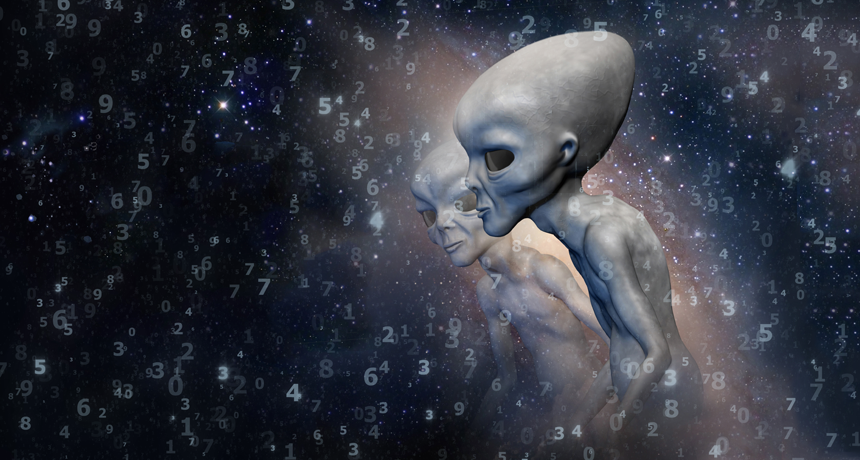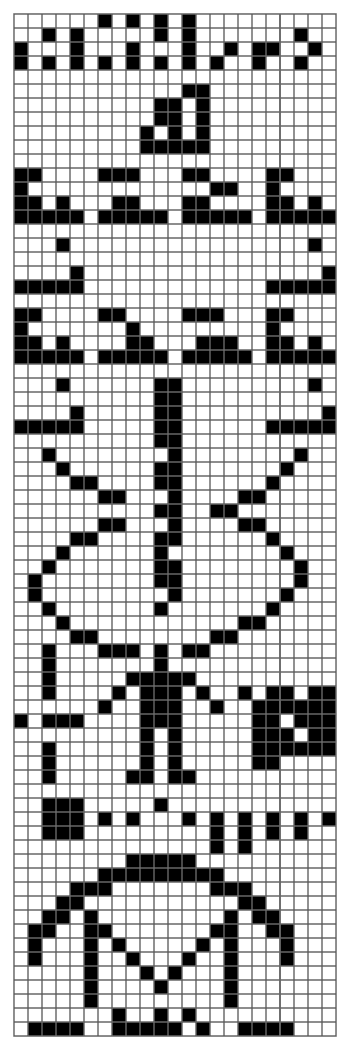Cool Jobs: Reaching out to E.T. is a numbers game
Scientists are using math to find aliens — and talk to them

The universal language may truly be numbers. That's why scientists are looking at math as the way to send a Hello and more to any extraterrestrials who might be listening.
Lena_graphics, ValeryBrozhinsky/iStockphoto; composite by L. Steenblik Hwang
By Ilima Loomis
This is the second in a three-part series on the search for extraterrestrial life.
On November 16, 1974, astronomers at the Arecibo radio telescope in Puerto Rico broadcast a powerful signal into outer space. Aiming their transmitter at a star cluster on the edge of our galaxy, they sent out a series of pings — 1,679 of them, to be exact. Why that number?

They knew 1,679 was unusual. It is the result of multiplying 23 by 73. Each is a prime number, a type divisible only by one and itself. The product of this equation would be unlikely to occur in nature. So the scientists hoped that if any aliens intercepted their broadcast, the number would show them that the pings were meant to be an intended signal. It might then help them decode the hidden message that those pings had contained (including pictures of DNA, the solar system and a stick figure).
Searching for aliens may sound like science fiction. Yet for many scientists, it has become serious business. Here we meet three who are using math in their quest to find other living beings in our universe. One is calculating the likelihood of finding life on other planets. Another is trying to figure out where best to beam a “hello” to E.T. The third is looking for a common language with extraterrestrials — and it will likely be numbers.
If we could talk to the aliens
Douglas Vakoch has spent a lot of time thinking about what he’d like to say to E.T. He is president of METI International in San Francisco, Calif. (METI stands for Messaging Extraterrestrial Intelligence.) His group is focused on broadcasting signals to outer space in the hope of contacting a civilization on some other world. Vakoch wants to use bright lights, such as lasers or perhaps a powerful radio telescope like the one at Arecibo (Air-eh-SEE-boh). But the big question: How could he write a message that aliens would understand?

“We don’t expect the extraterrestrials to be speaking English or German,” Vakoch explains. “So we look to mathematics as a universal language.”
The idea is simple. You need to understand math to build things. Any world advanced enough to have the technology to pick up our signals should also know how to work with numbers.
It’s not a new idea. Back in the 1820s, when astronomers still thought there might be little green men living on the moon, they suggested using geometry — the math of shapes — to communicate with them.
One scientist suggested planting trees or using mirrors to draw an enormous triangle in Siberia, a part of Russia. Another proposed digging a giant trench in the shape of a circle and filling it with kerosene. Then someone would light it on fire at night so that it would be visible from space. For these scientists, math was a way to show the aliens not only that we were here, but also that we were intelligent.
Vakoch’s plan is a little closer to what the Arecibo scientists tried in 1974. Back then, they used a binary system: two signals at slightly different frequencies. By sending out the signals in a series of bursts that form a pattern, scientists could create a kind of code, or draw pictures. The Arecibo team used its code to send a dense message. It included pictures.
Vakoch would start with something simpler: counting.
His first message would be seven signals at the same frequency: “ping-ping-ping-ping-ping-ping-ping.” Next, he’d send seven signals again but using two frequencies, like this: “ping-pong-pong-pong-pong-pong-ping.” He’d repeat that sequence four more times, then finish with seven “pings” again. If you draw that pattern on a piece of paper, you’ll see what the aliens will see if they decode his message: a box.
Next, Vakoch would add a third frequency to the code. By dropping in the third frequency at different places in the box, he could count numbers up to 25. By using a binary system — a way of representing numbers by combining zeros and ones — he could count into the millions. (The binary system is commonly used here on Earth. It can be found encoding the data in every computer.)
Once he introduced the code, Vakoch could then use it to send information. For instance, he might try to transmit the periodic table of the elements. It would list chemicals by their atomic numbers. This would show the aliens that we understand what the universe is made of. Another message might contain the Fibonacci sequence. This is a series of numbers that increase, with each successive number being the sum of the two before it. It’s a pattern that commonly appears both in nature and human art.
Even though he’s speaking in numbers, Vakoch wants to do more than count at the aliens. For him, math is just a tool to establish more meaningful communication. In the end, he says, “I want to know something about their culture, their society, their value system and what they see as beautiful.”
Story continues below image

Stay on target
So you want to talk to an alien. Just point your transmitter at the nearest star system and press “send,” right?
Wrong, says Philip Lubin. He’s a physicist at the University of California, Santa Barbara who works on directed-energy systems. These are powerful lasers that could be used to flash signals at other stars. While radio signals spread out as they travel across space, lasers are tightly focused. That means it’s important to aim them precisely. Being off by just a few degrees to either side could cause the signal to miss its target.
Big as a star is, hitting it with a laser is not easy. For one thing, when you look at a star in the sky, you’re seeing light that has been traveling through space for years — maybe thousands of years. “What you see is where the star was,” Lubin says. But its light was traveling to Earth, the star has moved. So you have to project your message into the direction where you think that star will be when your message is due to arrive.

And don’t forget, it will take years for the light from Lubin’s lasers to travel through space in the other direction. And that star is still moving. “It’s like taking a flashlight and trying to shine it at a spacecraft flying by,” he says. “If you want to shine your flashlight at it and have it hit it, you have to know something about the trajectory of the spacecraft.”
Astronomers use math to determine proper motion — a measurement of how objects in outer space change their apparent position in our sky. To do this, the scientists calculate the object’s angle relative to Earth. Next, they figure out how fast it’s moving and in what direction.
Many astronomical objects are so distant that those angles are measured in arcseconds or even smaller milli-arcseconds. Each are tiny amounts describing angles that are less than one degree in size. By calculating proper motion, Lubin can figure out where a star system will be when his signal arrives. “You have to figure out not only where the star is now, but where it will be in the future,” he emphasizes.
Is anybody out there?
For many scientists, trying to communicate with aliens is jumping the gun. They are asking more basic questions: Are we alone in the universe? What are the odds that life exists anywhere else? These scientists use math to figure out whether Earth is likely to be a lonely outpost in space, or one of many inhabited worlds in a universe teeming with life.
More than 50 years ago, astronomer Frank Drake devised an equation to estimate the number of extraterrestrial civilizations whose signals we might pick up from Earth. To get this number, he multiplied many factors. These included the rate at which new stars form, the number of stars with planets that host life and the number of life-bearing planets where that life would be intelligent. Just one problem: Almost all of the variables in this now-famous “Drake Equation” are still unknown.
“It’s not an equation that you can make predictions with,” says Avi Loeb. “It’s an equation that summarizes what we don’t know.” Loeb is a physicist at Harvard University in Cambridge, Mass. He decided to look at the search for extraterrestrial life from a different perspective. Instead of asking how much life exists in the universe, he wanted to know when in the history of the universe life would be most likely to develop?
For this, Loeb developed an equation of his own. It looks at different types of stars, the rate at which they form and how long they live. When he crunched the numbers, Loeb came up with a surprising conclusion: In the scale of cosmic time, the glory days when the universe is full of life might still be far ahead of us.

Many scientists had assumed that life most likely would occur in star systems similar to our own. After all, we know our sun can support life. If life exists elsewhere in the universe, sun-like stars are probably where we would find it, right?
Those sun-like stars usually burn out after some 6 billion years, Loeb knew. Yet there are stars that live longer. Some very small ones can survive for around 10 trillion years! And many of these small stars have planets. Might these planets also support life?
“If the answer is yes, then we know we [on Earth] are premature,” he says. Stars like our sun burn out quickly. So when our sun and its kin are gone, “the life that will remain is life around low-mass stars,” he argues. These are those tiny stars.
Unlike the Drake Equation, Loeb’s math contains only one unknown variable: whether low-mass stars can host life. He hopes other scientists will investigate that question in the decades ahead. “Once we know that, it can be folded into my equation,” he says.
Scientists in the search for extraterrestrial intelligence, or SETI, know they are unlikely to meet a Vulcan or Klingon in their lifetime. Still, they are excited to explore our universe for signs of life. Whether they’re figuring out the odds that we’re alone, or writing messages to aliens and beaming them out to other worlds, they couldn’t carry out this search without turning to numbers.
This is one in a series on careers in science, technology, engineering and mathematics made possible with generous support from Arconic Foundation.







